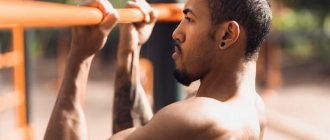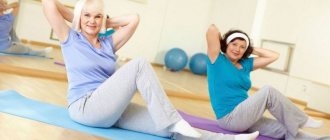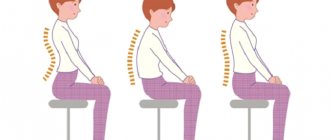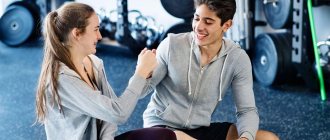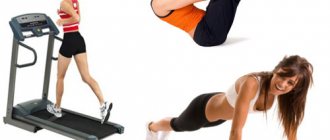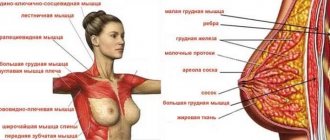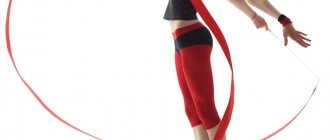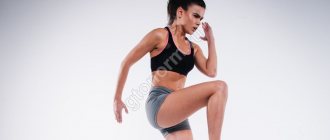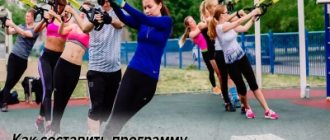A properly selected set of physical exercises for home is an excellent alternative to systematic trips to the gym. After all, everyone wants to look good and have a spectacular figure. However, not everyone manages to go to the gym regularly. A constant lack of time, financial difficulties or other obstacles become the main reasons why many give up sports, and in vain. If you properly develop a training regimen and purchase a few simple sports equipment, home exercises will prove to be very effective.
The benefits of gymnastics for adults
Individual or group gymnastics is not only a fashionable trend in fitness, but also an interesting way to spend time together for a group of friends or colleagues.
Gymnastic exercises:
- accelerate metabolism, stimulate the body’s immune system, as a result of which a person loses extra pounds, strengthens the immune system - less likely to suffer from colds and viral diseases;
- “unload” the brain and increase performance. Gymnastics classes for beginners are low-intensity, so they are recommended by doctors as a means of combating stress, chronic fatigue, and depression. Regular training increases the production of “joy hormones” - serotonin and dopamine, the concentration of which directly affects the feeling of fatigue;
- increase sexuality - due to the normalization of blood circulation, women and men experience an increase in libido;
- strengthen the cardiovascular system, normalize blood pressure, reduce the risk of blood stagnation and the appearance of varicose veins;
- stimulate the lymphatic drainage system, help the body cleanse itself of harmful accumulations and toxins;
- solve sleep problems.
The gymnastics club is a place for new meetings and acquaintances. By signing up for gymnastics, a person joins a community of people who are equally passionate about sports, for whom movement is life.
In order for gymnastics to be beneficial, you must practice under the supervision of a trainer, follow the technique of performing the exercises, and also do not neglect stretching before and after exercise.
General developmental gymnastics
General gymnastics is a common type of physical activity. There is no bet on results or records; all classes are aimed at developing a person’s physical capabilities, improving health, and increasing muscle tone. The training complex is based on basic fitness exercises that, when performed correctly, do not injure joints and tendons.
The general gymnastics section is especially useful for people with problems with the cardiovascular system and musculoskeletal system. It is recommended to use individual exercises from the training cycle as a set of morning exercises to awaken the body and get a boost of energy for the whole day.
General gymnastics also acts as preparatory measures for heavy loads: it warms up the muscles, accelerates the blood, develops ligaments, and improves joint mobility. More information about this type of physical activity can be found in the SOYUZ club, where group and individual classes in general developmental gymnastics are held.
Strength gymnastics
Strength gymnastics involves exercises with weights to create additional resistance to the muscles. Today, both men and women choose this type of fitness. Regular training allows you to build muscle mass, remove fat deposits, tighten and improve body contours.
Each lesson consists of three stages:
- warm-up, with cardio exercises to warm up muscles and joints, preparing the body for stress;
- strength exercises - for beginners, your own weight is often enough;
- stretching exercises.
You can do strength gymnastics at home, but at the first stage it is better to join a sports club to master basic exercises under the supervision of a trainer. He will monitor your body position, draw up a training program, and select a load in accordance with your level of physical fitness.
For those who are bored with lifting weights, we recommend paying attention to CrossFit. The SOYUZ club employs professionals in this area, so you can easily get detailed advice, see the strength training of champions and be able to decide whether strength gymnastics is right for you or not.
Gymnastics
It should be understood that rhythmic gymnastics for adults is one of the types of fitness training, and not a serious application for Olympic records. All exercises are performed in a limited amplitude and do not require super preparation from childhood.
When choosing a gym and trainer, be sure to attend 1-2 classes as an observer. You will appreciate the future mentor's working style, atmosphere, as well as the required level of physical fitness.
As a rule, women come to training who want to discover new capabilities of their body, improve flexibility and coordination of movements, and develop a sense of rhythm. Exercises with additional equipment (balls, ribbons, jump ropes, mace) add variety, help you gain a regal posture, strengthen muscles, and remove fat deposits.
Acrobatic gymnastics
In many ways it has something in common with artistic gymnastics - jumps, steps, and dance steps are also perfected here. People often sign up for training sessions with friends and colleagues - working together strengthens social connections and interpersonal trust, helps to loosen up and gain a sense of leverage.
Modern gymnastics is multifaceted: you can become seriously interested in acrobatics, train in a group, receive ranks and perform in competitions. Or you can simply study individual elements for yourself, surprise your loved ones with success and enjoy small victories.
Health-improving gymnastics
Health-improving gymnastics is one of the forms of physical education, which, as a rule, does not require good physical preparation and is aimed at the general improvement of a person , improving the current state of the body, increasing efficiency and quality of life.
To practice recreational gymnastics, no special physical training is required.
Some types of health-improving gymnastics have long received well-deserved recognition, others are only gaining popularity in the last few decades.
Morning exercises (exercises)
Charging involves a set of simple exercises aimed at activating physiological processes in the body after waking up.
Basic movements:
- turns and tilts of the head;
- rotational movements of the shoulders and torso;
- swing your arms and legs, etc.
A set of exercises lasting 15-20 minutes provides a charge of vivacity and positive mood for the whole day.
Morning exercises should begin with rotations and tilts of the head.
It has been scientifically proven that morning exercises have a beneficial effect on all organs and systems of human life:
- stimulates blood circulation and metabolism;
- optimizes the functioning of the heart and respiratory organs;
- develops muscles and joints;
- strengthens the immune system, etc.
Introductory gymnastics
Introductory gymnastics are small sets of exercises that have found their application in enterprises and organizations before the start of the working day. Their task is to ensure a person’s rapid entry into work .
Introductory gymnastics is carried out in factories before starting work.
Therefore, all exercises in their content and focus are as close as possible to the actions performed during work. As a natural result , staff performance increases.
In general, the following exercises are used:
- steps and running in place;
- various types of movements of the arms and body;
- muscle stretching exercises;
- exercises to improve concentration, etc.
The duration of the gymnastics is 5-7 minutes. Form of implementation: collectively or individually.
Physical education (physical education minutes in educational institutions)
Physical education is a type of gymnastic exercise that is used in educational institutions (mainly in primary schools and preschool institutions). Physical education sessions usually consist of 3-4 special exercises. Their duration does not exceed 1.5-2 minutes.
The form may be:
- dance;
- sports;
- motor - speech;
- warm-ups for fingers or eyes;
- breathing exercises.
Physical education lessons have proven to be an effective way to maintain students’ performance. It is noted that their implementation allows you to relax the nervous system and skeletal muscles that are tense from prolonged sitting at a desk.
Physical education helps improve the mental and physical performance of students.
In addition, physical education sessions provide necessary rest for the eyes and hearing organs. And ultimately, they help students overcome fatigue and drowsiness and relax mentally.
Hygienic gymnastics
The task of hygienic gymnastics is to ensure that the human body is maintained in the healthiest possible condition. A distinctive feature from other types of gymnastics is the combination of physical exercises with hardening elements and hygienic components (control of ambient temperature, clothing and footwear, hygiene, etc.).
Regardless of the type of hygienic gymnastics, the exercises can be performed at any age and with any physical fitness.
In addition to general strengthening exercises, stretching exercises are used. No improvised means are required.
Essentially, the concept of hygienic gymnastics combines the following types:
- morning exercises (exercises);
- gymnastics during the working day (introductory, physical education);
- evening exercises (before bedtime).
Hygienic gymnastics is suitable for people of any age and different levels of training.
Rhythmic gymnastics
Rhythmic gymnastics (rhythmics) - physical education classes in dance form. The exercises used are simple, but effective, because they cover all muscle groups. Their tempo, form and intensity depend on the music. Characteristic movements are: flexion and extension, turns and rotations, swinging legs and arms, running, jumping, jumping, etc.
Rhythmic gymnastics is a simple combination of exercises that are performed exclusively to rhythmic music.
Regular exercise has a beneficial effect on the functioning of the heart and lungs , strengthens muscles, develops endurance and a sense of rhythm. From an emotional point of view, rhythmic gymnastics improves mood, relieves tension and adds vitality.
Physiotherapy
Designed for the rehabilitation of patients with neurological and cardiac problems, injuries of various nature and origin, etc.
Therapeutic gymnastics is performed under the full supervision of the attending physician.
All therapeutic gymnastics exercises are performed statically , that is, as a rule, they are done slowly and under tension. Their action is aimed at improving the functioning of a specific organ. Therapeutic exercises are often combined with breathing exercises.
The scope of therapeutic exercises is very extensive:
- injuries and disorders of the musculoskeletal system (including immobilization);
- scoliosis;
- neurological diseases, etc.
Form of classes: in groups and individually. The general course of treatment usually consists of 3 stages: introductory, main and final.
Don't miss the most popular article in the section: Body drying for girls. Training program, detailed nutrition menu for the month by day.
Where to start classes?
Modern people often do not have enough time to go to the gym, so a large number of people stop at home exercises. In order for gymnastics for beginners to be fruitful and become a habit, you need to remember a few recommendations:
- You need to develop the habit of waking up 15 minutes earlier than usual. This is necessary so that the lesson has a normal pace, because no one wants to reduce the usual time allotted for hygiene, eating and cosmetic procedures.
- As soon as a person wakes up from sleep, he should not jump out of bed. First you need to do a couple of breathing exercises and self-massage. All this will help you recover faster after sleep and cheer up.
- You need to choose exercises that will correspond to the degree of training and the general condition of the body. Perhaps a person suffers from some kind of disease, in this case, before starting classes, you need to consult with your doctor.
- The number of repetitions of exercises should be selected individually. The same applies to the rhythm of movements.
- The load should be increased gradually. If discomfort or shortness of breath appears, you need to stop doing the exercise or reduce the load.
- Gymnastics for beginners must include exercises in which the load is evenly distributed to all parts of the body so that all muscle groups are involved.
- When doing gymnastics, you need to monitor your breathing. It should be uniform and deep. This will allow the muscles to be fully saturated with oxygen.
- It is best to exercise in special comfortable clothing that does not restrict movement. It is better if the training suit is made of cotton fabric.
- If possible, it is preferable to do gymnastics in the fresh air. As a last resort, you can open the window.
- It is best to do gymnastics while listening to fast and rhythmic music. This will allow you to tune in to a positive mood.
- After training, it is recommended to take a shower.
- During the day, you should try to do at least a few exercises that will help relieve stress.
- Walking is a must every day. In this case, you should perform special breathing exercises.
- If a person has already started doing gymnastics for beginners, then one should not stop training under any circumstances. The only exception is a very high temperature or a serious illness.
General rules
As far as we know, any sport is useful not only for men, but also for women. This is especially true when doing athletic gymnastics. Mostly women engage in this sport in order to lose extra pounds and make their figure more attractive by pumping up their leg muscles and removing their belly, as well as making their buttocks more elastic. Unfortunately, the rules are the same and they apply to both men and women:
- Include running in place and jumping rope into the complex. When performed for a short duration, these exercises are highly effective in the fight against excess weight.
- Choose exercises aimed at correcting problem areas. This individual approach to training increases their effectiveness.
- Drink water during training; an imbalance in water balance will not only reduce the effectiveness of your workouts, but will also lead to health problems.
- Eat no earlier than 2 hours after finishing your workout. Eating earlier will reduce all efforts to zero. Before classes, but no later than an hour before them, eat foods high in protein - legumes or soy products.
On a note! Regular exercise reduces physical stress on the body as a whole. By increasing calorie consumption, weight loss occurs much faster.
Sample training program for beginners
Such exercises are performed with additional weight, which can be dumbbells or any other suitable load.
Sample exercises:
- Feet are placed shoulder-width apart, and arms are raised above your head, holding the load. The next movements are bending down so that the hands with the load pass between the legs. This exercise is repeated up to 15 times.
- Position - standing straight, holding your hands with a load at chest level. The arms are straightened, after which the load is lifted above the head. You need to keep your back straight. The movements are repeated up to 15 times.
- The legs are placed at a level wider than the shoulders. The load and arms are raised above the head, after which bends are made, now in one direction, then in the other. The arms do not bend. The number of such movements is up to 12 times in one direction and the other.
- Position: lying on your back. The legs can be secured by sliding them under a sofa or under a closet. The arms are extended above the head and the torso is raised. The number of such movements is up to 12 times.
- Feet are together, and arms with a load are lowered in front of you. Raising your arms up and spreading your legs to the sides, you perform a low jump. The jumps are repeated about 15 times.
Gymnastics
Sports types of gymnastics require a high level of training. Training begins in early childhood. Sports achievements and victories are the main goal and motivation for those who are passionate about artistic gymnastics. Types (classification) include: acrobatic, rhythmic, artistic and team gymnastics.
Gymnastics
Recognized as one of the most vibrant, elegant and memorable sports. Performances by female athletes are a set of exercises and elements accompanied by music . All movements are characterized by elegance and plasticity.
Rhythmic gymnastics involves the use of various attributes by athletes. it can be a ribbon, a ball, a hoop and others.
At world-class competitions, it is mandatory to use various objects: ribbons, balls, hoops, etc. Classes develop flexibility , plasticity, grace, and form correct posture and gait.
Rhythmic gymnastics has age restrictions. They begin to engage in it at the age of 3-5 , and, as a rule, already at the age of 14-16, most female athletes end their careers and go into other directions. This sport is one of the most accessible, but it has quite high requirements for the appearance of female athletes.
Acrobatic gymnastics
Acrobatics is a section of gymnastics that consists of exercises such as:
- jumping;
- power;
- ability to maintain balance;
- rotation of the body with and without support, and a number of others.
Exercises are performed either on the floor or using special equipment (rings, parallel bars, gymnastic beams). They can be dynamic (somersaults, flips, somersaults) and static (stands, pyramids).
To engage in sports acrobatics, you must have special physical training.
There are a number of disciplines in sports acrobatics:
- soloists;
- couples;
- groups;
- trampolining.
Acrobatics develops agility, courage, determination, willpower, dexterity, strengthens the musculoskeletal system, develops coordination and orientation in space.
Sports aerobics
Sports aerobics is a discipline in which all exercises are performed at a very high tempo with musical accompaniment. All movements are characterized by sharpness and dynamism.
The athlete is required not only to have complexity and precision in the actions performed, but also to be artistic.
Competitions are held both individually and in groups. It should be noted that sports aerobics is an extremely difficult sport in terms of the physical load that a gymnast is exposed to during a performance. According to experts, his work can be compared to running 800m.
Sports aerobics performances are distinguished by their clarity and mobility.
Regular sports aerobics classes allow you to maintain good physical shape, have a positive effect on the emotional state of the athlete, and help strengthen the cardiovascular and respiratory systems.
Gymnastics at home: exercises for weight loss
As you know, in order for your body to start losing weight, you must burn more calories than you consume. Diets alone cannot solve this issue, so you need to add gymnastics to your daily activity. It should be taken into account that exercises in such gymnastics must be energy-intensive, i.e. you must make efforts “to the maximum”, to do through “I can’t”. It is these activities that will force your body to work in an enhanced mode, during which calories will be lost.
What should be effective gymnastics at home, exercises for which are designed to literally “burn” calories? These workouts should include all muscle groups. A set of exercises, for example, may be as follows.
- “Scissors” - this exercise perfectly works the abdominal muscles. To perform it, you need to lie on the floor, rest your hands on it, and begin to slowly raise your legs to an angle of 90 degrees, while crossing them alternately. In the same way, you need to slowly lower your legs down. This counts as one time. Perform three sets of 10-15 reps.
- “The book” is an exercise for the press that involves all the muscles of a given part of the body. Sit on the floor with your hands shoulder-width apart behind you and tilt your head back slightly. Then simultaneously pull your legs, bent at the knees, and your body towards each other, as if “folding”, like a book.
Squat plie. Place your feet as wide as possible while still maintaining stability. Spread your socks slightly to the sides. Then, from this position, perform a squat, moving your pelvis back, as if you were sitting on a chair. Make sure that your knees bend strictly towards your toes. For greater efficiency, you can take weights into your hands, for example, several heavy books.
- Lunges in place - take a wide step forward with your right foot, while your left remains motionless. In this position, squat down completely, bending your “dropped out” leg at the knees. Please note that the knee of the right leg should not go beyond the toe, and the knee of the left should not touch the floor. Do 10 of these squats, switch legs. For greater efficiency, you can take small dumbbells in your hands.
- Jumping jumps from a seated position: To do this, place your feet shoulder-width apart and perform a squat. This position will be the starting position. You need to jump out of it sharply, while simultaneously stretching your arms in the same direction. Then return to the starting position and immediately jump out of it, i.e. without stopping or pausing.
- Reverse grip push-ups: sit on the edge of a chair or sofa, then lean your hands on the furniture from behind, stretch your legs in front of you (you can bend your knees). Begin to push up from the edge, as if “sagging” down, while your pelvis and back should be on the same line. Imagine that you want to sit on the floor from this position.
All exercises are performed in 3-4 approaches, each with 10-15 repetitions.
Exercises with weights: connecting the legs
Dumbbells can also be useful for working the lower body, although it will be much more convenient to use Velcro weights placed on the legs.
You can simply hold the additional weight in your hands and perform basic leg exercises with it - squats or lunges. Barbell squats are a classic part of a women's body workout program and are believed to create the ideal shape of the hips and buttocks. But squats with weights require perfect technique for performing the exercise - they should not be too deep so as not to injure the knee joint. The position of the pelvis also plays a significant role - ideally it should be moved back a little, and in no case should it sag in the lower back.
The following exercise is suitable for training your abs: sit with your legs straight ahead and holding a dumbbell between them. Try to keep your back straight. Bend your knees and pull them towards your chest while holding the dumbbell. Try to do 10-15 repetitions. Make sure that the lower back does not sag and the abs do not fall out of work due to excessive involvement of the back muscles.
Another abdominal exercise: Sit on the edge of a chair with dumbbells resting on your feet. Raise your legs parallel to the floor as many times as possible. In order to work your abs well, you must sit on the very edge. If you move back in your seat, the mechanics of movement will change: you will bend and extend your legs at the knees, and this will engage the thigh muscles more.
The “Roman chair” exercise, in which the legs are fixed and the body leans back, requires good coordination and considerable abdominal strength, and when using additional weights in the form of dumbbells held at the shoulders, it becomes even more difficult
This exercise should be treated with special attention if you have any problems with the lower back, as here it experiences excessive stress
Features of classes at home
It is necessary to find the optimal rise time. You must have time to get everything done and still fit exercise into your schedule. The duration of classes for beginners is 10-15 minutes, and for those who have already more or less adapted to the stress - half an hour. After finishing charging, it is recommended to take a contrast shower for 10 minutes.
It is better to do all exercises on an empty stomach, having breakfast after exercise. You can also drink a glass of water after waking up - this will help start the gastrointestinal tract and help thin the blood.
Each exercise consists of three stages: warm-up, a set of basic exercises, and a final complex. It is necessary to distribute the load evenly. It is recommended to perform the exercises in order: from simple to complex. If you feel unwell, stop exercising. You shouldn’t torture yourself and practice through pain and discomfort.
Warm-up
Before charging, you need to do a short warm-up. Perform all exercises smoothly, without sudden movements.
Rotation of the head and neck
Smoothly tilt your head alternately to the left and right, then tilt forward so that your chin touches your chest.
The next exercise is rotational movements of the head clockwise and counterclockwise.
The last thing is turning the head to the right and left.
Warm-up, stage 1
Warm up your arms
Raise your arms to chest level and clasp your palms. Rotate your wrist joints, then your elbow joints. Stretch your shoulder joints by moving your arms outstretched or bent at the elbows in a circle, forward and backward.
Warm up your arms
Warm up your arms
Warm up your arms
Back and body
Hands on the belt, perform circular movements with the hip joint clockwise and counterclockwise.
Hip rotation
The next thing is to bend towards your left and right legs, straightening your back.
Legs
Raise your leg in front of you, bend your knee slightly and begin to rotate your ankle. If you have difficulty maintaining your balance, find support or rest your hand on a wall.
Finish your warm-up by walking in place. Let's move on to charging.
Exercises without objects
The most convenient and affordable training option is to perform exercises without additional sports equipment. Freedom of action gives you the opportunity to be active outside the gym or fitness club, at home or in the fresh air. In this case, the load is your own weight, frequency and sharpness of movements.
Below are several universal exercises that can be included in your gymnastics complex:
Starting position: standing, feet shoulder-width apart, shoulder blades pulled together, head raised, and eyes looking forward. We alternately raise our arms up through the sides, forward, do “scissors” and “wheel”, doing at least two repetitions for each of the listed movements.
Exercise "Birch"
Starting position: lying down.
Feet on the wall, hip-width apart. The arms are extended along the body and rest against the wall. Inhaling, we tense our buttocks, pull our tailbone in and lift our pelvis up. We try to push the pelvis with the feet away from the wall and bring it vertical. We move the shoulder blades, sacrum and hips, shoulders away from the ears as much as possible. We hold our back with our hands. If there is discomfort in the neck, keep the pelvis slightly lowered and place the body weight on the shoulder blades. You can stay with this option or complicate it: stretching your right leg up, continue to push the wall with your left leg.
Change the position of your legs and repeat the exercise. Keep your pelvis tucked.
To exit, we lower both feet onto the wall, stretch our arms along the floor and lower our back down in a smooth wave.
Universal training
The general complex of kinesitherapy is suitable for every patient, regardless of age and health status. To select exercise therapy for a specific disease, you should consult a doctor.
Daily training (lasts 15-30 minutes).
Warm up in a standing position: stretching with raising your hands clenched into fists; rotation and tilting of the head in different directions.
1st block of exercises, do lying on your back:
- Pull your arm up, lifting your shoulder blade off the floor as much as possible – 8 times.
- “Frog”: bent legs on the feet; spread your knees to the sides, fixing your feet – 7-9 times.
- Half-bridge: hands on forearms, bent legs on feet; lift your body up, straightening one leg 5-6 times.
- Hands behind your head, legs bent. Raise the top of the body 10-12 times.
- To complicate the exercise: as you inhale, lift your body and tilt your bent legs to the side; as you exhale, lower your body and raise your outstretched legs. Repeat in the other direction, 7-9 times.
- Hands at your sides. Simultaneously turn the head and legs bent at the knees in different directions, 15-20 times.
- “Birch” against the wall: press your buttocks and feet against the wall, push off, straightening your lower back, 5-7 times.
- Pull straight arms and legs perpendicularly upward, repeat 6 times.
2nd block of exercises:
- Lie on your side, pull your straightened leg forward and backward 8-10 times.
- Lying on your side, describe a circle with your straight leg 8-10 times.
- Lying on your side with support on your elbow, pull your lower leg, bent at the knee, towards your chest 4-6 times on each side.
- Do push-ups from the floor with crossed legs, hands inward, back straight, 5-10 times.
- “Cat”: arch and bend your back while inhaling and exhaling 5-10 times.
- Lying on your stomach, bend upward while lifting your body and head 6-8 times.
- Sit on your heels, hands behind your head, head and chin forward. Turns in different directions, back straight, 10 times.
- Sitting on your heels, straighten up, spread your arms to the sides and rotate your shoulders back and forth 6-12 times.
- Standing on your knees, head down, chin pressed to your chest. Turn to the sides 7-10 times.
- After completing the complex for beginners, a relaxing cool-down is carried out (lying on your back, relax, watching your breathing).
A set of exercises for online training in rhythmic gymnastics
State budgetary educational institution
additional education of the Arkhangelsk region
"Palace of Children's and Youth Creativity"
Methodological development
“Online training complex No. 1 with a gymnastic ball for groups of 2nd year of study and older.”
City of Arkhangelsk
2020
CONTENT
Explanatory note
The choice of teaching methods is of particular relevance in the modern world. This is due to the emergence of conditions under which it becomes impossible to work offline and you have to switch to distance learning.
This methodological development proposes a set of exercises for special physical training in rhythmic gymnastics, which can be used both in standard training and using various video communication platforms. The complex is designed for students in the 2nd year of study and older.
There are no age restrictions, the physical fitness of the pupils is important. It is recommended to introduce exercises from the second year of study after learning basic movements gradually, alternating them in different classes.
Regular use of exercises in rhythmic gymnastics classes allows you to:
- improve physical and functional readiness;
- carry out work with the subject more clearly and efficiently;
- reduce “subject anxiety” in group and personal presentations;
- increase interest in classes.
The set of exercises is presented in table form. The first column contains the numbering of exercises, the second column describes the exercises, the third gives methodological recommendations for performing these exercises, and the fourth contains the dosage (it depends on the preparedness of the athletes).
The methodological development is written on the basis of personal experience and the generalized experience of colleagues. The development may be useful for teachers and rhythmic gymnast coaches. Some exercises can be used by teachers and coaches of other related sports fields.
Children come to training warmed up, stretched and doing the splits. Lesson duration 45 minutes. The time and quantity of exercises depends on the level of readiness of the children. For beginners, you can reduce the set of exercises, but increase the execution time. For experienced gymnasts, you can increase the pace of completing the task with the same total time.
Standing on high toes, place the ball under your feet, arms to the sides.
The foot should be completely adjacent to the ball. The support is on the half-fingers, not on the ball. The gymnast’s task is to stand straight, without staggering, on straight legs, without lowering her arms.
1 minute
2
I.p. from exercise No. 1, hands in front. Do squats.
The gymnast should not sit on the ball while squatting, the body should be straight, and the arms should not fall below parallel. Support on the toes.
1 minute
3
I.p. squat on half toes, ball under feet, hands in front. Maintain this position.
The gymnast must hold the position without swaying, the ball fits tightly to the feet.
1 minute
4
I.p. sitting on the floor, ball in 1st hand, second to the side. Perform “pumping” with your right and left legs: raise and lower the stretched leg to an angle of 15°. While raising and lowering your legs, bounce the ball off the floor.
The main task is to work with a stretched leg, in an inverted position, and not to lose the ball when hitting. The back is straight and does not lean back.
1 minute per leg
5
I.p. sitting on the floor, raise one leg as high as possible. We hold the ball in both hands with a raised leg, and perform bounces with the ball.
The back should be straight, without bending back, knees straight, feet taut, turned out. Sit without leaning on one side. Hands are straight when hitting.
1 minute per leg
6
Sitting on the floor, the ball is held between the feet, arms to the sides. Raising your legs as high as possible.
The back is straight, a slight deviation of the body back is allowed, but without rounding the back. Legs rise straight at the same time.
2 minutes
7
Lying on your stomach, arms to the side, shoulders off the floor, head straight, continuation of the spine, eyes down, chin not pressed to the chest. The ball rests on the neck in balance. Raising your legs to an angle of 45° and lowering them back.
Work with tense knees and feet, legs turned to the 1st position. The ball must be in balance at all times.
2 minutes
8
Lying on your stomach, the ball is held in your feet. Perform a chest roll with the ball.
During the roll, do not bend your legs, keep your feet stretched. Hold the ball without twisting your legs together. During the roll, the hands are moved back, palms down.
2 minutes
9
Lying on your stomach, roll your legs toward the ceiling on your chest, holding the ball in your feet. Hands behind you, palms down. Bend your knees to your head and straighten them back.
The task can be performed with a break every 10 bends.
2 minutes
10
Lying on your stomach in a “cobra” position, arms straight near your ears. The ball is held in the feet, the knees are straight. We roll onto our chest, arms in front of us, bend our knees, and pass the ball into our hands. Then we straighten the nail and roll back, arching our back, head tilted back, arms straight. We pass the ball up and back to the feet.
The exercise is done at a “pendulum” pace, try to work immediately with straight legs and pass the ball from your hands with straight legs.
2 minutes
11
Lying on your stomach, the ball in your feet. Roll onto your chest with your legs parallel to the floor. We release the ball, make a rebound, slightly spreading our legs, catch the ball on top of our feet, roll the ball backwards along our legs, catch the ball under our stomach in our hands. We take the starting position.
Work with straight legs. Do not relax your back, keep your legs hanging without touching the floor.
2 minutes
12
Sitting on the floor, form a fold and place the ball on your neck for balance. Hold.
The fold is performed with a straight back, the stomach rests completely on the legs, looking forward. Knees straight, feet taut.
2 minutes
13
I.p. from exercise No. 12. Move your legs back through the rope and put them back together. The task is to keep the ball balanced.
We move our legs straight, with our tops looking at the ceiling with tense lifts for as long as possible.
2 minutes
14
Sitting, the ball is in two hands in front of you, lying on the back of your hands. Spreading your legs into a rope, lower your body down, hands with the ball remain in place, collect your legs behind you, roll the ball onto your neck for balance. Then we return the legs back, lifting the body through the round back and rolling the ball back onto the hands.
When we roll the ball into balance on the neck, the head drops down between the arms, the arms remain straight, slightly rising above the head. There is no need to roll the ball further than your neck onto your back. So that the skat is not fast and the ball stops on the neck, you cannot raise your arms high. The head should not stick out between the hands, as the ball will have nowhere to roll. As we rise back, we first begin to round our back, then roll out the ball, and only when the ball is closer to our hands do we raise our head.
2 minutes
15
Lying on your stomach, the ball in front of you in both hands. Roll onto your chest with force, without lifting your shoulders off the floor. Bend your legs on both sides of the ball, place your feet on the floor under the ball. Straighten your legs with the ball on your feet, extend your feet and roll the ball down your legs and back into your hands.
The main thing is to pick up the ball correctly with your feet; you don’t need to grab the ball from the sides by the middle, but take the ball by the lower part.
2 minutes
16
Standing, holding the ball in two hands from behind. Bend forward, arms from behind roll forward. Standing fold.
The fold is performed on straight legs, the back is straight. Fold as close to your feet as possible.
1 minute
17
I.p. from No. 16. When performing a fold, hit the ball over your head, straighten up and catch it in your hands.
Work with straight arms.
1 minute
18
Standing, holding the ball over your head. Perform back bends while hitting the ball from behind.
When leaning back, the arms do not bend, the ball is hit by releasing the ball, and not by purposefully hitting it as in a standing position. The rebound is performed when the gymnast has not reached the full tilt phase, but is caught already in the tilt.
1 minute
19
Sitting on the splits, the ball in the 1st hand. Raising yourself above the floor with your leg muscles, roll the ball under you from one hand to the other.
The lifting occurs with slight support on the back knee, the back is straight, the arms are straight, and when rolling the ball should not touch the legs.
1 minute per leg
20
Sitting on the splits, arms up with the ball. Bend back and straighten back up.
If the gymnast has a good stretch, you can sit down from a hill. When bending back, the arms and head go first, the shoulders are slightly behind, lifting occurs due to the abdominal muscles, and the arms and head complete the movement. Sit in a straight split. When bending, your hands should touch the back leg evenly. If your arms are on the side of your leg, then the split is not even.
3 minutes on each leg
21
I.p. as in No. 20. When bending back, bend your back leg.
The leg that bends should pass between the hands, the ball should touch the floor behind the leg.
2 minutes per leg
22
I.p. sitting on the floor with the ball clutched in your knees. Raising our legs up, we place our hands in a bridge position near the head, we perform a roll-up on our knees (raising the pelvis up, bending our legs and placing them instead of our head, pushing ourselves up from the floor with our hands) going through the position of bending back. The moment your feet kneel, the ball bounces off the floor.
The tackle is done in all phases together, without stopping. After hitting the ball, catch the ball in 1 hand.
3 minutes
Health-improving acrobatics
When the proposed exercises strengthen the main muscle groups, gymnasts begin complex acrobatic positions and tricks. Many people dream of learning how to make a wheel. Making a wheel is not so difficult if the muscle tone is normal and there are no diseases accompanied by dizziness.
Kinesitherapy - gymnastics at home - is useful for losing weight and strengthens the skill of maintaining balance in different body positions. First you need to master a handstand against a wall. It's easy to do:
- Stand next to the wall, facing it;
- Bend over and place your hands on the floor;
- Shift your weight to your hands, lift one leg off the floor;
- Place your straight leg against the wall and pull up your other leg;
- Keep your balance by resting your heels on the wall.
For those who are no strangers to home kinesitherapy, after 3-6 months, balance exercises turn out well. It's easy to do a cartwheel from a handstand against a wall (with support at first) by slowly lowering one leg down the wall. The pelvis and second leg will automatically begin to move, the lower back will bend and spring, the arms will push the body off the floor.
Exercises against a wall with support are done until the body “remembers” the algorithm of the trick.
When it learns to balance easily, it’s time to try doing a half-turn handstand. You need to practice in a spacious room, lay mats on the floor.
The main condition for correctly performing the “wheel” exercise is to keep your arms and legs straight. Then the wheel will be smooth, in one plane. If you are afraid of not maintaining your balance, you need to train with a partner so that he can provide backup for the beginning gymnast. After a week of training, the wheel will turn out on its own.
Exercise “Crescent Pose”
Stand with your right side to the wall, the right sides of your feet and pelvis touching the wall. We lean forward and lift our chest up. We put the body weight into the right leg, lift the left leg up and turn the pelvis and chest into one plane. We stretch our left arm up, look at the floor, and do not fall onto the wall. Lightly touch the wall with your shoulder blades, pelvis and leg. Don't squeeze your neck, move your shoulders away from your ears. Hold the pose for as long as you can.
Change your lifestyle
Those for whom kinesitherapy is primarily a means of losing weight should remember that home exercises alone are not enough. The following rules must be followed:
- Stick to proper nutrition;
- Do not eat an hour before training and 2 hours after it;
- Drink at least 1.5-2 liters of clean water per day;
- In addition to home exercises , include swimming and running 2-4 times a week;
- After a month of training, you should gradually increase the load: do more repetitions and combinations of exercises.
There are many sets of exercises for weight loss that are not related to kinesitherapy (therapeutic gymnastics). They are designed for young and healthy people who want to correct their figure. There are known exercises for losing weight in the abdomen, arms, legs, buttocks, and back - complex and varied.
But for those who are overweight and are not in good health, it is still better to engage in exercise therapy - and the weight will return to normal and your health will improve.
Recent beginners, after losing weight and strengthening all muscle groups, will be able to perform the wheel and other acrobatic exercises.
Where does aerobics begin?
Like any other sport, aerobics must begin with a warm-up.
We bring to your attention exercises that will help prepare your body for a more complex load at home.
Stretch your neck muscles
We stand straight, feet shoulder-width apart. Now we begin to perform circular movements of the neck clockwise, then counterclockwise. Number of repetitions – 10 times.
Without changing the starting position, we tilt our head forward, then back. Now left and right. Number of repetitions – 10 times in each direction.
Stretch the muscles of the arms and shoulder girdle
We stand straight, lower our arms down and clench them into fists. Then we begin to swing each hand separately, the opposite one should remain down.
Without changing the starting position, we bend the arms at the elbow joint and place our palms on the chest. Now we move our elbows back, first in a bent position, then in an unbent position. The number of repetitions is at least 15 times.
We stand straight, lower our arms down and relax them. We make circular movements with the shoulder joint, first in one direction, then in the opposite direction.
Stretch your core muscles
We stand straight, spread our legs at shoulder level, and place our hands on our belts. We begin to make turns with the body, first in one direction, then in the other.
This must be done carefully, with a gradually increasing amplitude of movement and speed. Number of repetitions – at least 20 turns in each direction
Without changing the initial position, we bend to the right and left, and we also need to reach with our hand in the direction in which we are leaning, for example, we lean to the right and stretch with our left hand. Number of repetitions: at least 10 bends in each direction.
We put our legs together and try to reach our toes with our hands.
We begin to do this exercise carefully and slowly, then gradually increase the pace. Number of repetitions – at least 20 inclinations
We stand up straight (if you are practicing at home, you need to stand near a wall or cabinet so that if something happens you can hold on) and bend one leg at the knee joint. Now we grab the heel with our hand and pull it towards the buttocks. Then we change the leg and do the same thing. Number of repetitions: 10 times on each leg.
And finally, we stand on our toes, raise our arms up and stretch as high as possible. We lower ourselves to the starting position and rest. The number of repetitions is at least 10 times.

